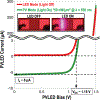A 250 μm × 57 μm Microscale Opto-electronically Transduced Electrodes (MOTEs) for Neural Recording
- PMID: 30334768
- PMCID: PMC6338085
- DOI: 10.1109/TBCAS.2018.2876069
A 250 μm × 57 μm Microscale Opto-electronically Transduced Electrodes (MOTEs) for Neural Recording
Abstract
Recording neural activity in live animals in vivo with minimal tissue damage is one of the major barriers to understanding the nervous system. This paper presents the technology for a tetherless opto-electronic neural interface based on 180 nm CMOS circuits, heterogeneously integrated with an AlGaAs diode that functions as both a photovoltaic and light emitting diode. These microscale opto-electrically transduced electrodes (MOTEs) are powered by and communicate through an optical interface, simultaneously enabling high temporal-resolution electrical measurements without a tether or a bulky RF coil. The MOTE presented here is 250 μm × 57 μm, consumes 1 μW of electrical power, and is capable of capturing and encoding neural signals before transmitting the encoded signals. The measured noise floor is as low as 15 μVRMS at a 15 kHz bandwidth.
Figures















Similar articles
-
Fabrication of Injectable Micro-Scale Opto-Electronically Transduced Electrodes (MOTEs) for Physiological Monitoring.J Microelectromech Syst. 2020 Oct;29(5):720-726. doi: 10.1109/jmems.2020.2999496. Epub 2020 Jun 12. J Microelectromech Syst. 2020. PMID: 33071528 Free PMC article.
-
A 0.45 V 100-channel neural-recording IC with sub- μW/channel consumption in 0.18 μm CMOS.IEEE Trans Biomed Circuits Syst. 2013 Dec;7(6):735-46. doi: 10.1109/TBCAS.2014.2298860. IEEE Trans Biomed Circuits Syst. 2013. PMID: 24473539
-
A Low-Power Current-Reuse Analog Front-End for High-Density Neural Recording Implants.IEEE Trans Biomed Circuits Syst. 2018 Apr;12(2):271-280. doi: 10.1109/TBCAS.2018.2805278. IEEE Trans Biomed Circuits Syst. 2018. PMID: 29570055
-
Recent Advances in Electrical Neural Interface Engineering: Minimal Invasiveness, Longevity, and Scalability.Neuron. 2020 Oct 28;108(2):302-321. doi: 10.1016/j.neuron.2020.10.011. Neuron. 2020. PMID: 33120025 Free PMC article. Review.
-
Semiconducting electrodes for neural interfacing: a review.Chem Soc Rev. 2023 Feb 20;52(4):1491-1518. doi: 10.1039/d2cs00830k. Chem Soc Rev. 2023. PMID: 36734845 Review.
Cited by
-
Bioelectronic devices for light-based diagnostics and therapies.Biophys Rev (Melville). 2023 Jan 20;4(1):011304. doi: 10.1063/5.0102811. eCollection 2023 Mar. Biophys Rev (Melville). 2023. PMID: 38505817 Free PMC article. Review.
-
Patterned electrical brain stimulation by a wireless network of implantable microdevices.Nat Commun. 2024 Nov 21;15(1):10093. doi: 10.1038/s41467-024-54542-1. Nat Commun. 2024. PMID: 39572612 Free PMC article.
-
A Micromechanical Transmitter with Only One BAW Magneto-Electric Antenna.Micromachines (Basel). 2022 Feb 8;13(2):272. doi: 10.3390/mi13020272. Micromachines (Basel). 2022. PMID: 35208399 Free PMC article.
-
Advances in Bioresorbable Triboelectric Nanogenerators.Chem Rev. 2023 Oct 11;123(19):11559-11618. doi: 10.1021/acs.chemrev.3c00301. Epub 2023 Sep 27. Chem Rev. 2023. PMID: 37756249 Free PMC article. Review.
-
Minimally invasive power sources for implantable electronics.Exploration (Beijing). 2023 Aug 31;4(1):20220106. doi: 10.1002/EXP.20220106. eCollection 2024 Feb. Exploration (Beijing). 2023. PMID: 38854488 Free PMC article. Review.
References
-
- Schenck JF, “The role of magnetic susceptibility in magnetic resonance imaging: MRI magnetic compatibility of the first and second kinds,” Medical Physics, vol. 23, no. 6, pp. 815–850, June 1996. - PubMed
-
- “https://www.braininitiative.nih.gov/,” [Online].
-
- Johnson B, Peace ST, Wang A, Cleland TA and Molnar A, “A 768-Channel CMOS Microelectrode Array With Angle Sensitive Pixels for Neuronal Recording,” in lEEESensorsJournal, vol. 13, no. 9, pp. 3211–3218, September 2013.
-
- Dragas J, Viswam V, Shadmani A, Chen Y, Bounik R, Stettler A, Radivojevic M, Geissler S, Obien MEJ, Müller J and Hierlemann A, “In Vitro Multi-Functional Microelectrode Array Featuring 59 760 Electrodes, 2048 Electrophysiology Channels, Stimulation, Impedance Measurement, and Neurotransmitter Detection Channels,” in IEEE Journal of Solid-State Circuits, vol. 52, no. 6, pp. 1576–1590, June 2017. - PMC - PubMed

